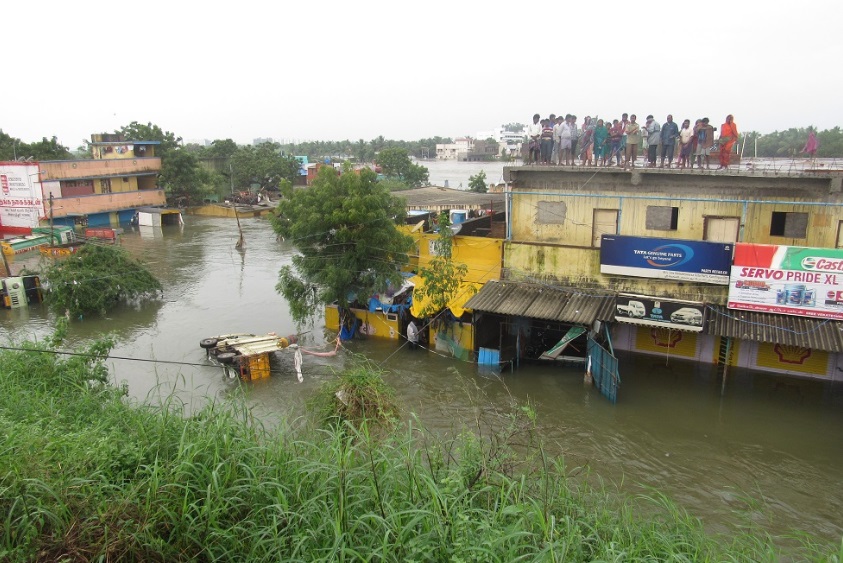In 50 Years, Over 1.3 Lakh Indian Lives Lost In Extreme Weather Disasters
May 24, 2023 | Pratirodh Bureau
Extreme weather events like floods, apart from climate and water-related events caused 573 disasters in India between 1970 and 2021 that claimed 1,38,377 lives, according to data from the World Meteorological Department (Photo by Destination8infinity/Wikimedia Commons)
Source: PT, DW
Extreme weather, climate and water-related events caused 573 disasters in India between 1970 and 2021 that claimed 1,38,377 lives, according to data from the World Meteorological Department, a specialised agency of the United Nations.
Globally, 11,778 reported disasters led to more than two million deaths and USD 4.3 trillion in economic losses during this period.
Over 90 per cent of the reported deaths worldwide occurred in developing countries.
The WMO issued the new findings for the quadrennial World Meteorological Congress which opened in Geneva in Switzerland on Monday with a high-level dialogue on accelerating and scaling up action to ensure that early warning services reach everyone on earth by the end of 2027.
The “United Nations Early Warnings for All initiative” is one of the top strategic priorities due to be endorsed by the World Meteorological Congress, WMO’s top decision-making body.
Asia reported 3,612 disasters attributable to weather, climate and water extremes, with 9,84,263 deaths and USD 1.4 trillion in economic losses.
“Between 1970 and 2021, Asia accounted for 47 per cent of all reported deaths worldwide, with tropical cyclones being the leading cause of reported deaths. Tropical cyclone Nargis in 2008 led to 1,38,366 deaths,” the WMO said.
Bangladesh reported the highest number of human deaths (5,20,758) in Asia due to 281 events, the data showed.
In India, 573 disasters reportedly killed 1,38,377 people between 1970 and 2021.
In Africa, 1,839 disasters caused 7,33,585 deaths and USD 43 billion in economic losses. Droughts caused 95 per cent of the reported deaths.
Tropical cyclone Idai in March 2019 was the costliest event that occurred in Africa (USD 2.1 billion).
“The most vulnerable communities unfortunately bear the brunt of weather, climate and water-related hazards,” WMO Secretary-General Prof. Petteri Taalas said.
Extremely severe cyclonic storm Mocha exemplifies this. It caused widespread devastation in Myanmar and Bangladesh, impacting the poorest of the poor, he said.
The frequency of extreme weather events such as floods and heatwaves is projected to rise manifold in India in the future due to climate change, according to a report released by researchers at the Indian Institute of Technology, Gandhinagar, last year.
The study said the risk will increase significantly under the warming climate and variability in the El Nino-Southern Oscillation (ENSO) — a recurring climate pattern involving changes in the temperature of waters in the central and eastern tropical Pacific Ocean.
Climate change has increased the instability in the atmosphere, leading to an increase in convective activity — thunderstorms, lightning and heavy rain events. Cyclonic storms in the Bay of Bengal and the Arabian Sea are also intensifying rapidly and retaining their intensity for a longer duration due to global warming, according to meteorologists.
India recorded 2,227 human casualties due to extreme weather events in 2022, according to the Annual Statement on Climate of India, issued by the India Meteorological Department.
Meanwhile, even as billions face life-threatening heat, a global network of heat officers are tackling the problem in their own cities.
It is estimated that about 2 billion people will live in hazardous heat conditions by the end of the century if climate policies continue on their current trajectory, according to new research published in the Nature Sustainability journal. That represents 23% of the projected global population.
If the climate warms more drastically — a potential scenario under current policies — about 3.3 billion people could face extreme temperatures by the end of the century.
The study, led by scientists at the UK’s University of Exeter and Nanjing University in China, found that 60 million people are already exposed to dangerous heat levels, characterized by an average temperature of 29 degrees Celsius (84.2 Fahrenheit) or higher.
